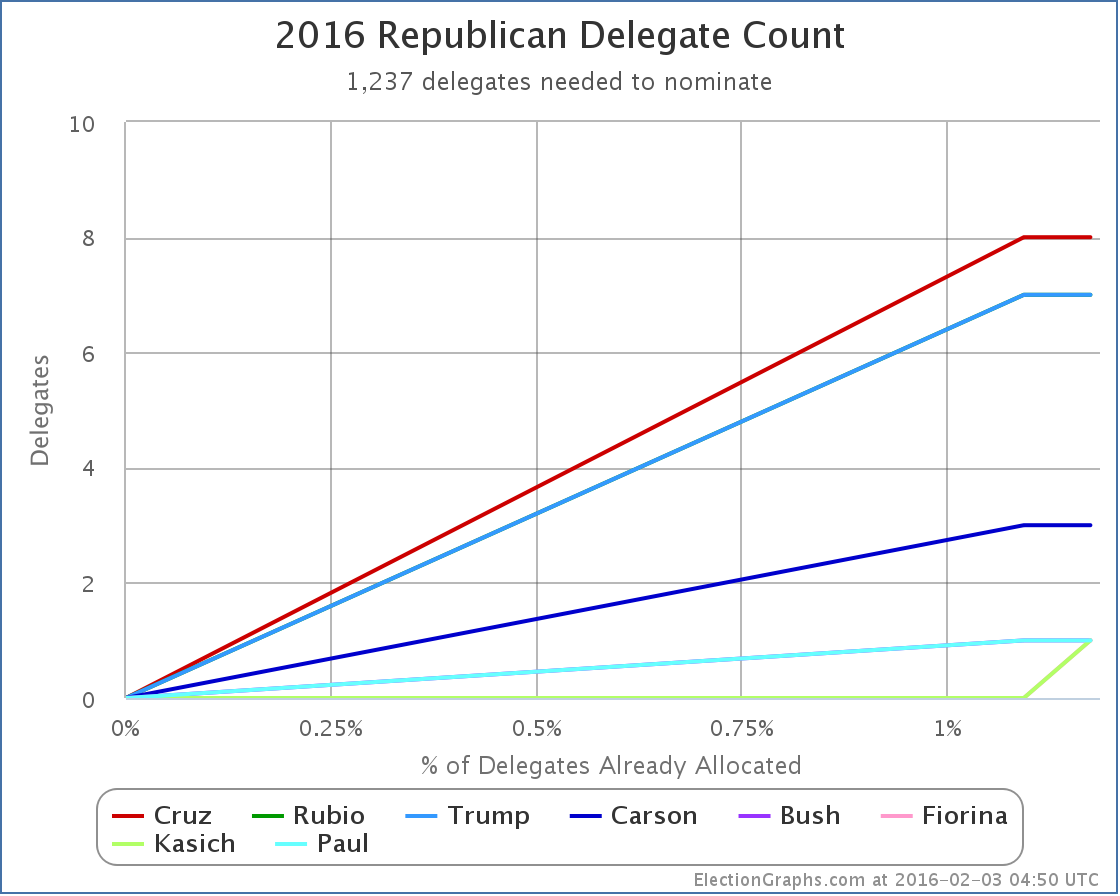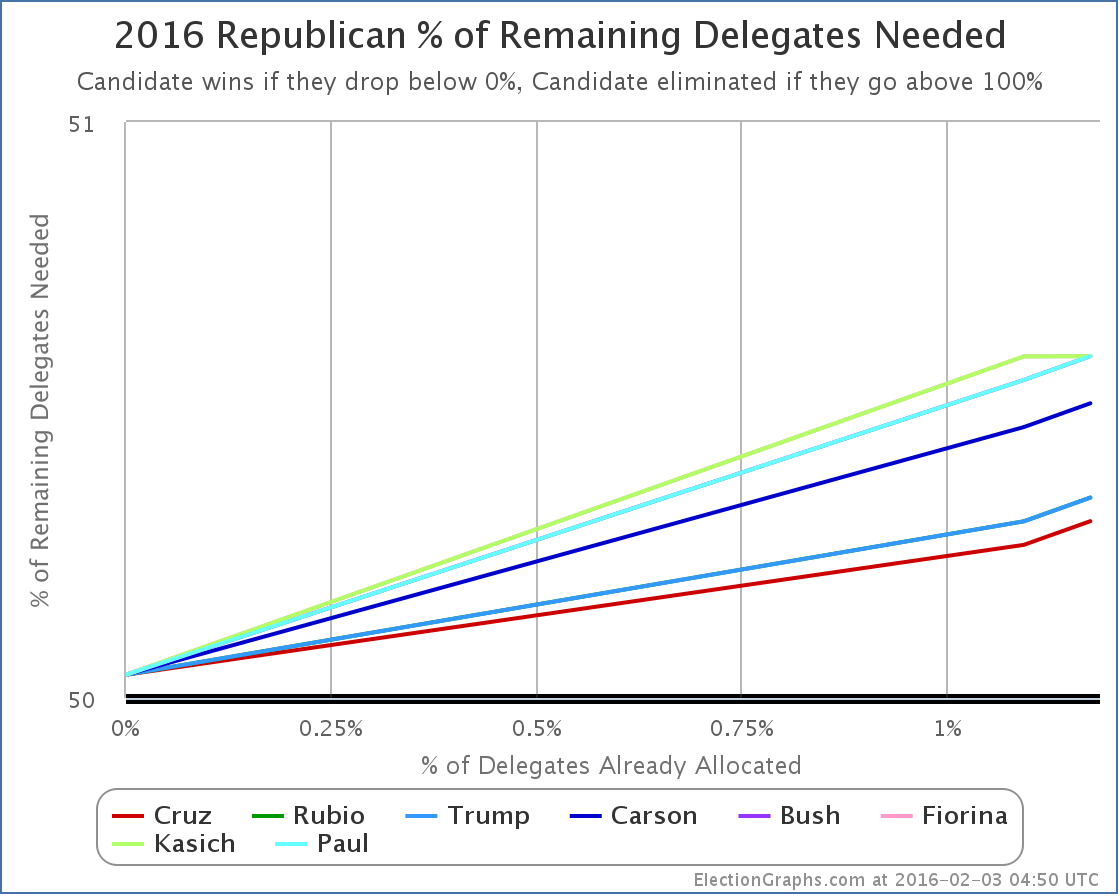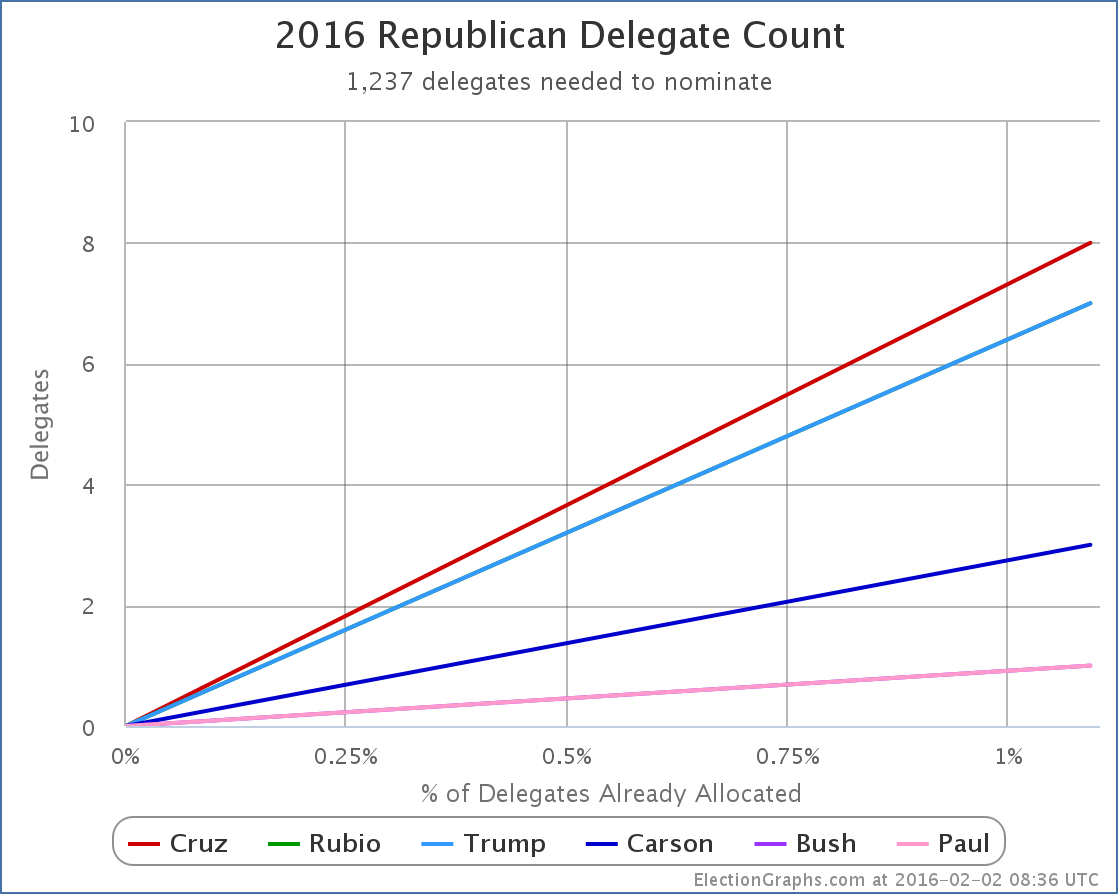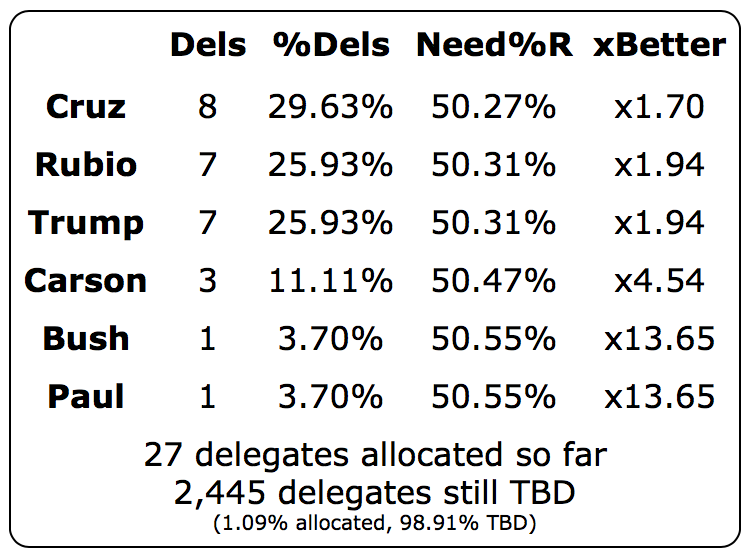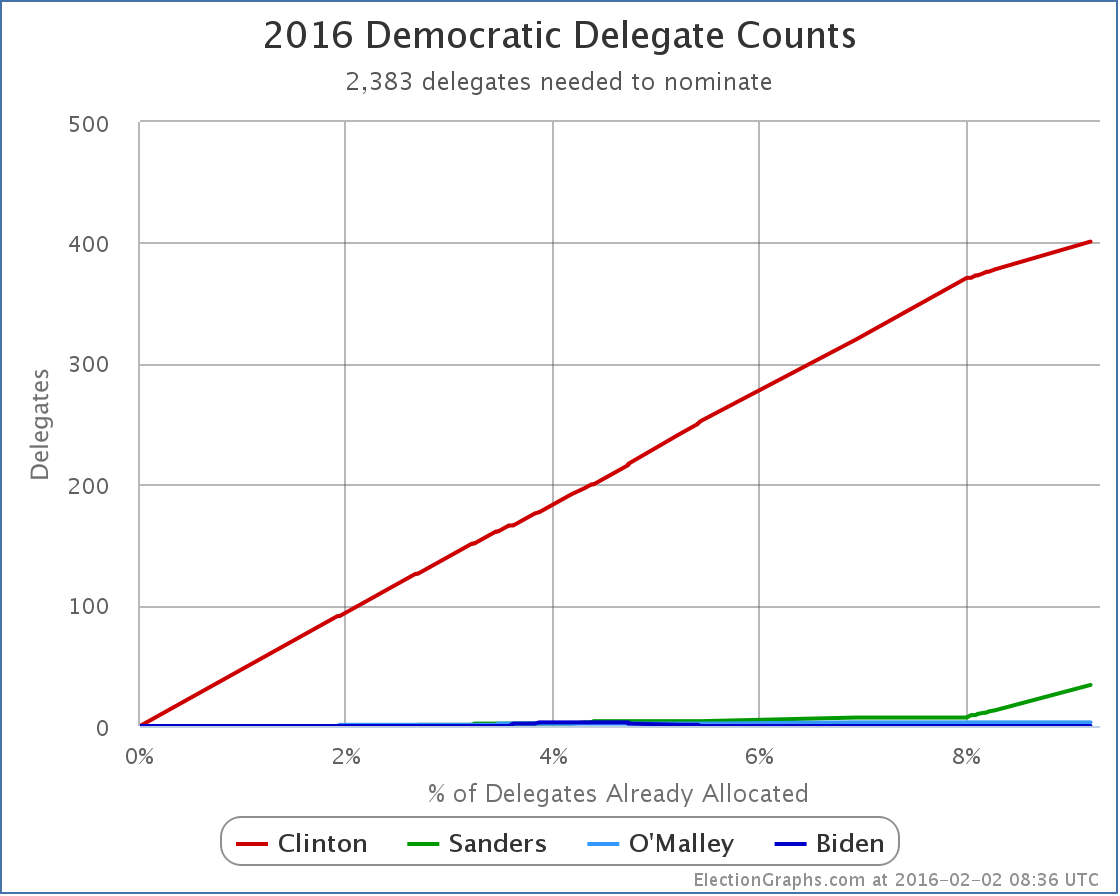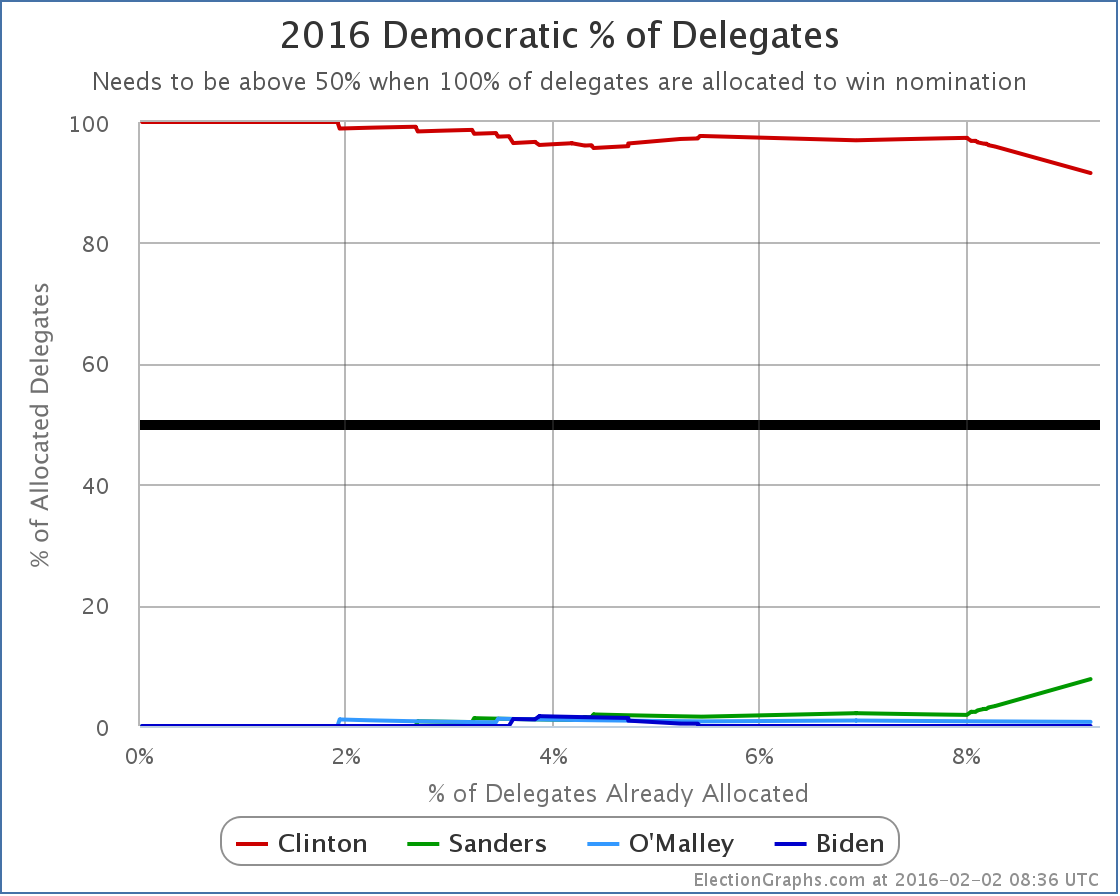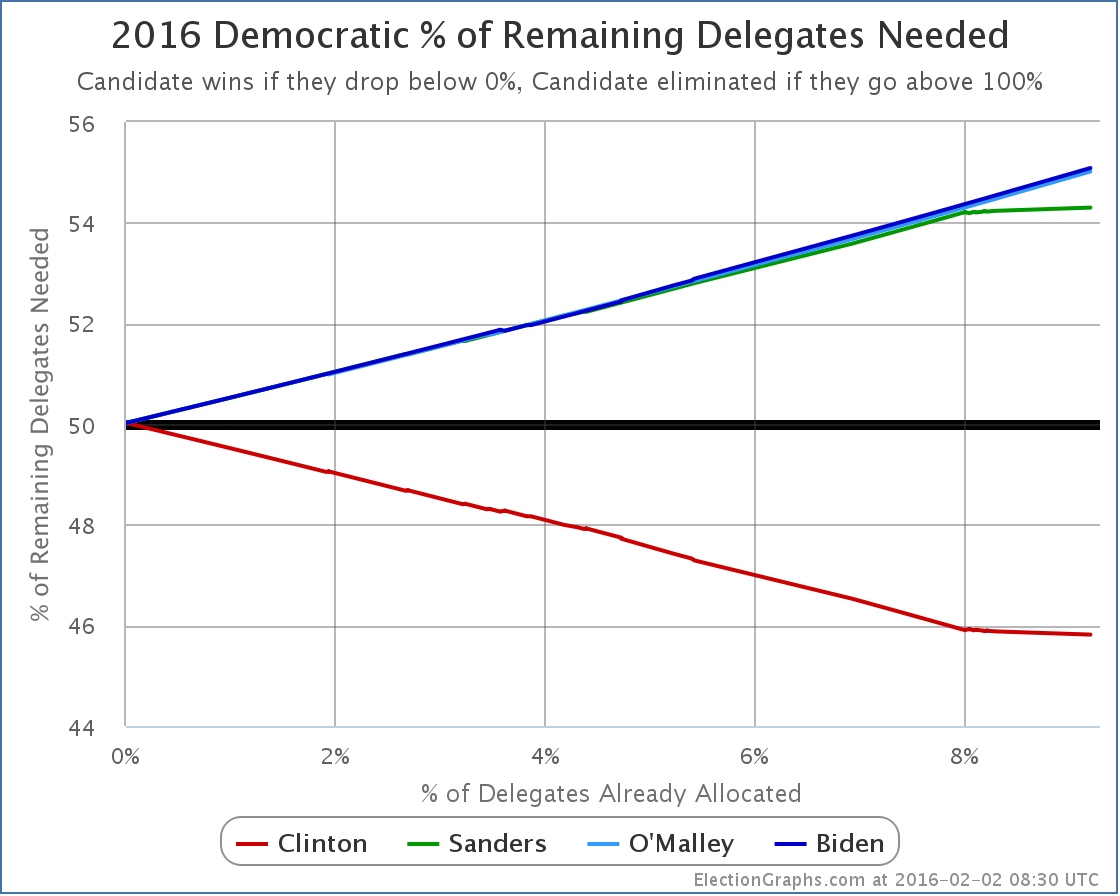- 00:13:14 Retweeted @TheRickWilson 2016-02-02 23:59:49 Seriously…Trump is rattled and it tastes like unicorn tears.
- 00:15:02 Retweeted @amandacarpenter 00:02:28 We are seeing a completely new Donald Trump tonight. Even keeled, calm, chill. Wow.
- 00:17:38 Retweeted @morningmoneyben 00:08:55 Trump on losing Iowa: "It could have been the debate."
- 01:06:24 Retweeted @dmataconis 2016-02-02 23:40:27 It looks like Paul, Fiorina, Santorum, and Gilmore will not be invited to Saturday's GOP debate. No undercard this time
- 02:54:21 Running 100.7 F fever. Lovely.
- 03:09:24 Retweeted @TheGreenPapers 03:08:57 @abulsme Don't know. I have yet to hear from the Iowa GOP, then if it is different, i'll have to work the math backwards. in reply to abulsme
- 03:11:55 .@TheGreenPapers Looks like some places (Politico/WaPo) now have 8-7-7-3-1-1-1-1, which would be your mix + party dels for Cruz & Rubio. in reply to TheGreenPapers
- 04:21:23 Retweeted @DLeonhardt 01:54:23 1. Iowa is 1 of 5 states most favorable to Sanders.
2. He lost.
3. Absent evidence from SC, the "long fight for Hillary" case seems weak. - 04:49:28 Yup -> Consequences of Iowa: Trump still strong, new life for Rubio, long-term trouble for Sanders (@SamWangPhD) https://t.co/fCuAeMgHGV
- 05:09:25 Retweeted @daveweigel 04:55:03 NO NO NO NO https://t.co/b3HuQgRiX7
- 05:18:34 Retweeted @JenniferJJacobs 2016-02-02 17:05:38 The missing Democratic votes are now logged, making the score in the Iowa caucuses:
Clinton: 699.57
Sanders: 697.77
#iacaucus - 05:48:38 Retweeted @7im 05:43:03 Rand paul got 20,000 fewer votes than his dad did in 2012
- 15:58:13 Retweeted @NYHammond 14:37:43 If Trump thinks the caucuses were unfair, wait until he finds out about the Electoral College.
- 16:00:53 Bye bye Rand!
- 16:01:10 Anybody else leaving before New Hampshire?
- 17:43:30 [Abulpost] Republicans: Minor Delegate Shuffling and a New Hampshire Hypothetical https://t.co/Pk2PFBiYcA
- 18:54:27 Retweeted @JohnKingCNN 18:51:42 Another GOP departure: CNN has learned @RickSantorum will exit race tonight. Plans endorsement.
- 21:05:04 Retweeted @taylordobbs 20:37:41 Jeb Bush's "please clap" video: https://t.co/yMryXMKV1d
- 21:06:23 Retweeted @gov_gilmore 20:32:20 Started out as 1 of 17 GOP Candidates, now with Rand Paul & Rick Santorum out, 1 or 9. #StillStanding
- 21:07:08 Retweeted @katiezez 20:36:31 Cruz goes after Trump in NH, saying that Trump is "losing it," his 5, 7 yr olds are better behaved, might wake up to see Trump nuked Denmark
- 21:15:39 Retweeted @NateGoldman 14:39:20 "Please clap" supplants Hemingway's six-word story as the shortest, saddest story ever told https://t.co/tEkYI2OnEV https://t.co/jHIrTnwIiT
|
Yesterday’s update was preliminary, and I ended up using the delegate estimates provided by the AP which were used at the New York Times, Washington Post, and other places. My favorite source, Green Papers, had a different set of numbers. When I tried to calculate delegate numbers myself, I came up with yet another set of numbers. I ended up going with the AP numbers. A little more than a day later and Green Papers updated, now matching what I had calculated myself. So I’m updating the estimates accordingly. This moves us from: 8 Cruz, 7 Trump, 7 Rubio, 3 Carson, 1 Bush, 1 Paul to 7 Cruz, 7 Trump, 6 Rubio, 3 Carson, 1 Bush, 1 Fiorina, 1 Kasich, 1 Paul. The main change here is one less delegate each to Cruz and Rubio, with those delegates picked up at the bottom end by Fiorina and Kasich. But wait! There is more! The Washington Post and Politico both add two additional delegates. The 27 allocated by the caucus results were already accounted for, so these would be two of the three “party leaders” who end up as automatic delegates. No indication of which party leader did what, but they add one additional delegate each to Cruz and Rubio. The new Iowa totals become: 8 Cruz, 7 Rubio, 7 Trump, 3 Carson, 1 Bush, 1 Fiorina, 1 Kasich, 1 Paul. Between these two changes, the net is simply adding the delegates for Fiorina and Kasich. This means 29 of the 30 Iowa delegates are now accounted for. Note that even though Paul has “suspended his campaign”, he keeps his delegate unless he explicitly releases it. The raw delegate count chart now looks like this: Just a little uptick at the end for Fiorina and Kasich to join Bush and Paul at the 1 delegate mark. Flipping this over to look at “% of remaining needed to win”: On this chart, lower is better. When you get down to 0% you win. If you get to 100% you are eliminated. Everybody is still heading upward, not downward, but it is still very early. The whole field here ranges from needing 50.31% of the remaining delegates, to needing 50.59% of the remaining delegates. Looking specifically at New Hampshire, there are 20 delegates at stake. We are so early, and the % needed numbers so close, that this is easy. The number needed to be on track to win is 11 delegates. Anything less, and the candidate is actually going to be in a harder position in the next contest rather than an easier one. Let’s game out New Hampshire based on the current RCP averages. Yes, yes, this is based on polling before New Hampshire. Things will change in the next six days. But this is just to model how it works. The rules via The Green Papers:
Assume each candidate gets exactly their poll average today. Only the candidates over 10% matter, so with RCP as of right now that is: 33.4% Trump, 12.2% Cruz, 10.8% Rubio, 10.4% Kasich Converting this to delegates with the rounding rules above, you get: 7 Trump, 2 Cruz, 2 Kasich, 2 Rubio This is only 13, so there are 7 delegates left. According to the last rule, these all go to the leader, so we end up with: 14 Trump, 2 Cruz, 2 Kasich, 2 Rubio And therefore Trump would get 70% of the delegates despite only getting 33.7% of the vote. Trump’s line on the “% needed to win” would go down, while everybody else would go up. After this hypothetical New Hampshire result, the overall race would be: 21 Trump, 10 Cruz, 9 Rubio, 3 Carson, 3 Kasich, 1 Bush, 1 Paul, 1 Fiorina. Trump would still only have 42.9% of the delegates, which is not a majority, but Cruz would be way back at 20.4% and you’d have Trump starting to pull away from the pack. Still only 1.98% of delegates allocated at that point though, with lots of room for further changes. The RCP average on February 3rd is NOT going to look like the actual results on Primary night. This is just an example. The points to take away:
Of course New Hampshire will be here soon enough, and we’ll do this with the real results. Note: This post is an update based on the data on ElectionGraphs.com. Election Graphs tracks both a poll based estimate of the Electoral College and a numbers based look at the Delegate Races. All of the charts and graphs seen in this post are from that site. Additional graphs, charts and raw data can be found there. All charts above are clickable to go to the current version of the detail page the chart is from, which may contain more up to date information than the snapshots on this page, which were current as of the time of this post. Follow @ElectionGraphs on Twitter or like Election Graphs on Facebook to see announcements of updates or to join the conversation. For those interested in individual general election poll updates, follow @ElecCollPolls on Twitter for all the polls as they are added.
Unlike the Democrats, the Republicans didn’t have years of superdelegates endorsing one candidate or another, so Iowa really was a clean slate. The very first delegates earned in the race for the 2016 Republican nomination. The headlines are of course that Trump underperformed the poll-based expectations letting Cruz slide to a win, while Rubio outperformed his expectations, coming in a close third. This is all true. But it is also true that only a tiny fraction of the delegates have been allocated so far. None of the candidates got a majority in Iowa either. So nobody is actually yet on a track to overall victory. Cruz may be slightly ahead, but Trump and Rubio are right at his heels. Cruz is not in a dominating position. It really is a three person race. Looking at the raw delegate graph quickly… …you immediately notice that we just have a really boring graph with a few straight lines. And Rubio’s line and Trump’s line completely overlap too. As do Bush and Paul’s lines. That’s because this is our first real data point after everyone was just at zero. All of the graphs are like this. So just this once, lets skip the graphs and look at the summary table instead: I’ll note here that Green Papers has slightly different numbers. But the New York Times, Washington Post, and CNN all agree with the estimates above, so for the moment that is what we’ll go with here. It is clear that Cruz/Rubio/Trump are in a separate class here than Carson/Bush/Paul. But even these three would need to nearly double their performance to actually be on a track to win, because, well, you have to be getting more than half of the delegates to win outright. 25% to 30% won’t get you there. So at some point, somebody has to start going over the 50% mark if there is going to be a winner. There is plenty of time for that of course. Nobody is predicting a contested convention quite yet, as much fun as that would be. We probably won’t see anyone over 50% after New Hampshire either, but how close we get may depend on the viability thresholds. In New Hampshire on the Republican side you need to get 10% of the popular vote to be eligible for delegates. Although this will definitely change in response to the Iowa results, at the moment RCP has Trump at 33.2%, Cruz at 11.5%, Kasich at 11.5%, Bush at 10.3%, and Rubio at 9.5%. The rest are pretty far from 10%. But that is four candidates all within a couple percent of 10%. Depending on which of those ends up right above or right below the 10% threshold, you could see very different delegate results coming out of New Hampshire. Most likely, we’ll have three or four candidates over 10% and a mix of delegates, but in the extreme case, if all but Trump drops under 10%, then Trump gets all the delegates. So a wide range of things is possible based on really small movements from the current positions in the polls. Final points here though to the people saying Iowa proves that Trump is done…
We have a three way race right now. It is not inconceivable that a 4th candidate could do well enough in New Hampshire to join that group. Things are just as up in the air and chaotic on the Republican side as they were before Iowa. Anything could still happen. Stay tuned. Note: This post is an update based on the data on ElectionGraphs.com. Election Graphs tracks both a poll based estimate of the Electoral College and a numbers based look at the Delegate Races. All of the charts and graphs seen in this post are from that site. Additional graphs, charts and raw data can be found there. All charts above are clickable to go to the current version of the detail page the chart is from, which may contain more up to date information than the snapshots on this page, which were current as of the time of this post. Follow @ElectionGraphs on Twitter or like Election Graphs on Facebook to see announcements of updates or to join the conversation. For those interested in individual general election poll updates, follow @ElecCollPolls on Twitter for all the polls as they are added. The Iowa caucuses have finally come and gone, and we have the first “earned” delegate results of the nomination race. Sorta. No actual Democratic delegates were actually determined. It was just the first step in a multi stage process. But as of now, estimates can be made. The estimates as per The Green Papers are 23 delegates for Clinton and 21 for Sanders. There were also 4 Iowa superdelegates already for Clinton. So the Iowa totals as of this post are: 27 Clinton, 21 Sanders, 4 superdelegates TBD. Even if all 4 remaining superdelegates went for Sanders, which is unlikely, Clinton still wins Iowa 27 to 25. This despite the predominant reporting of tonight’s results as a tie or near-tie for Sanders. In addition, since my last post on the Democrats in other states there have been 3 additional super delegates who came out for Clinton, and 2 who came out for Sanders. So, where does that put us? First, the raw delegate totals: You can see the “kink” in the chart that is the result of Clinton getting a much smaller percentage of the Iowa delegates than her absolute domination in the superdelegate race. This of course means her percentage of the delegates so far takes a bit of a swoon: Clinton is down to only 91.55% of the delegates allocated so far! That’s the lowest she has been so far! OK, that is down, but actually it is still pretty dominant. But what does all this do to the critical “% of remaining delegates needed to win”? When I made the last blog update, Sanders needed 54.22% of remaining delegates to win. Right before tonight’s new Iowa results, that had moved to 54.23%. Adding in the Iowa results it is now… 54.30%. So up a little, but really not by much. Sanders did not do well enough to bring this percentage down. It has to actually go down for Sanders to be on a pace to catch up and win. But he at least did well enough to keep it from getting very much worse than it was. Looking at the New Hampshire polling, Sanders is currently at 55.5% in the RCP average and 55.2% in the Pollster average. Either way, that is a smidgen above 54.30%. So even if he gets no boost in New Hampshire from his near tie with Clinton in Iowa, Sanders may meet the bar he needs in order to improve his numbers on this metric. He doesn’t have much leeway though. If he drops at all, then he essentially will fall even further behind after New Hampshire. The states beyond New Hampshire of course look more hostile to Sanders based on early polling. To make any real race out of this, something would need to happen that would cause Clinton to not just do a little worse, but a lot worse. Otherwise, the rest of this Democratic race is just going to be a process of Clinton mopping up, no matter what sort of media hubbub results after a potential Sanders win in New Hampshire. Note: This post is an update based on the data on ElectionGraphs.com. Election Graphs tracks both a poll based estimate of the Electoral College and a numbers based look at the Delegate Races. All of the charts and graphs seen in this post are from that site. Additional graphs, charts and raw data can be found there. All charts above are clickable to go to the current version of the detail page the chart is from, which may contain more up to date information than the snapshots on this page, which were current as of the time of this post. Follow @ElectionGraphs on Twitter or like Election Graphs on Facebook to see announcements of updates or to join the conversation. For those interested in individual general election poll updates, follow @ElecCollPolls on Twitter for all the polls as they are added.
|
||
